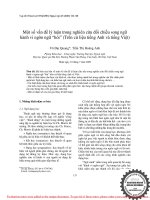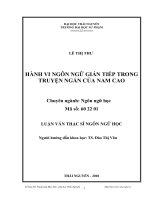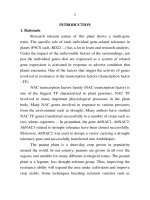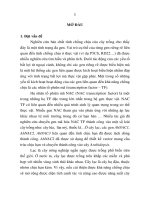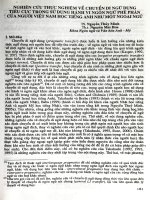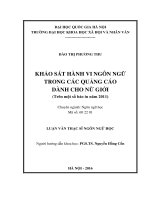hành vi ngôn ngữ thề (swear) trong tiếng việt bản tóm tắt tiếng anh
Bạn đang xem bản rút gọn của tài liệu. Xem và tải ngay bản đầy đủ của tài liệu tại đây (931.27 KB, 27 trang )
1
INTRODUCTION
1. Rationale
Research tolerant nature of this plant shows a multi-gene
traits. The specific role of each individual gene-related tolerance in
plants (P5CS such, RD22 ) has a lot to learn and research analysts.
Under the impact of the unfavorable factors of the surroundings, not
just the individual genes that are expressed as a system of related
gene expression is activated in response to adverse condition that
plants encounter. One of the factors that trigger the activity of genes
involved in resistance to the transcription factors (transcription factor
- TF).
NAC transcription factors family (NAC transcription factor) is
one of the biggest TF characterized in plant genomes. NAC TF
involved in many important physiological processes in the plant
body. Many NAC genes involved in response to various pressures
from the environment such as drought Many authors have studied
NAC TF genes transferred successfully to a number of crops such as
rice, wheat, cigarettes In groundnut, the gene AhNAC1, AhNAC2,
AhNAC3 related to drought tolerance have been cloned successfully.
Moreover, AhNAC2 was used to design a vector carrying a drought
tolerance gene and successfully transferred into Arabidopsis.
The peanut plant is a short-day crop grown in popularity
around the world. In our country, peanuts are grown in all over the
regions and suitable for many different ecological zones. The peanut
plant is a legume, less drought-tolerant group. Thus, improving the
resistance ability will expand the area under cultivation and improve
crop yields. Some techniques breeding resistant varieties such as
2
hybrid technology or applications of plant cells has been applied.
However, the techniques used to create transgenic varieties resistant
to drought has not been studied much. From the above reason, we
have carried out the theme: "Researching on isolating and
transferring NAC2 gene relating to the tolerance to drought of
peanut (Arachis hypogaea L.)"to test the ability of transgenic and
advanced directives to drought tolerance of transgenic plants to
produce transgenic lines serve in breeding drought-resistant peanuts.
Practical application of research to renovate peanut restrictions and
break resistant crops on this plant.
2. Objective of the study
(1) Isolation of genes encoding transcription factors NAC2
from drought tolerant peanut varieties.
(2) Design the structure vector containing the gene encoding
transcription factor NAC2. Create and transgenic plants expressing
NAC2 protein in tobacco plants.
(3) To create transgenic peanut lines. Analysis of transgenic
peanut lines.
3. Content of the study
(1) Grouping similar level of communication studies assessing
drought through drought tolerant callus phase and saplings.
(2) Isolation, cloning and sequencing of the gene encoding
transcription factor NAC2 related to drought tolerance of peanuts.
(3) Design vector containing the gene structure encoding
transcription factors NAC2, create A.tumefaciens bacteria carrying
the recombinant vector and transferred into the tobacco plant model.
(4) Determination of the presence of the transgene on tobacco
3
NAC2, evaluate drought tolerance of the transgenic tobacco lines
through changes in proline content. Analysis of recombinant protein
expression NAC2 in transgenic tobacco plants.
(5) Development of plant regeneration system in transgenic
peanut plants and directives (GUS) through callus and somatic
embryos.
(6) Transfer NAC2 genetic structure in tree nuts, peanuts
analysis of transgenic lines.
4. New contributions of the thesis
i) Successfully halftone genes encoding transcription factors
NAC2 from drought tolerant peanut L12.
ii) Design a vector containing the structural gene encoding
transcription factors NAC2 and transferred it into tobacco plants, the
expression of protein in transgenic plants has demonstrated that
structural design has worked well in tobacco .
iii) Through regeneration system has been built, tested
varieties LVT GUS transgenic and gene transfer structure encoding
transcription factors NAC2. GUS expression obtained on peanut
somatic embryo and complete. Obtained touch 4 generation T0 lines
carrying genes encoding transcription factors NAC2 through initial
inspection with PCR.
iv) Optimal dissertation and complete the complete process
through transgenic callus and somatic embryos in order to serve
peanuts to create transgenic peanut purpose improved resistance to
water shortages from the lip school.
5. Scientific significanceand practical
5.1. Scientific significance
4
i) The results of the thesis research has provided materials science
applications of GM technology in the interests of improving drought
tolerance of peanuts.
ii) Provide information about NAC transcription factors and genes in
peanut NAC2 as well as drought tolerance in peanut research and the
role of genes NAC2 in response to the lack of water from the
environment.
5.2. Practical significance
Results of evaluation of drought tolerance in peanut callus
level and young plants are used as a basis to assess and apply
measures to improve the drought tolerance of peanuts. Initial results
obtained on transgenic peanuts is a foundation for evaluationing at
the next level and serving continuous research on improving drought
tolerance of peanuts.
6. The structure of the thesis
The dissertation consists of 103 pages (including references),
is divided into sections: Introduction consists of 2 pages; Chapter 1:
Overview document, page 40, Chapter 2: Materials and Methods,
page 15, Chapter 3: Results and Discussion, page 47; Conclusions
and suggestions: 1; published works related to the thesis: 1;
references: 14 pages with 134 references in Vietnamese and English.
The thesis has 25 tables, 36 figures.
Chapter 1. LITERATURE REVIEW
The reference of theisis summarize 17 Vietnamese documents
and 117 foreign ones with related content, including: (1) Limit and
limit the impact of the plant, (2) The transcription factor related to
drought tolerance in plants, (3) Improving drought tolerance of plants
5
by gene transfer techniques.
With the data collected, analyzed results confirmed, optimism
is short-term agricultural crops grown in popularity around the
world. General trend of climate change makes unusual drought in
many areas, this is the main reason for the reduction in crop yields
includind peanuts. The understanding of drought tolerance
mechanisms will help to understand the resistance characteristics of
peanut plants and provide a basis for studies on the ability to respond
to water shortages from the environment. Mechanisms of plant
tolerance to drought is complex, involving not only morphological
anatomy but also related to the biochemical changes in cells,
regulating activity of the genes involved in resistance limit of
vegetation. The success of gene transfer techniques has been
published in many plant species and characteristics related to drought
tolerance of plants has improved .
Currently, there are two trends of research for genes involved
in plant tolerance to conditions of abiotic ecological disadvantage.
The first one is to find genes that are directly related to drought
tolerance, cold tolerance, waterlogging or alkaline Secondly
resistant genetic studies towards the control elements such as
transcription factor ( TF ) in oder to regulating overall better plant
when conditions are unfavorable. They NAC TF is one of them
featured in the largest plant genome. NAC transcription factors
functionally related to many different processes in the plant body,
such as development, aging, response to biological and non-
biological stress. Many studies mainly focused on the cloning and
identification of genes related to drought like NAC TF: ANAC019,
6
ANAC055 and ANAC072 from Arabidopsis, BnNAC from cabbage,
AhNAC1, AhNAC2, AhNAC3, AhWSI 153, AhWSI 308 from
peanuts, GmNAC2, GmNAC3 and GmNAC4 in soybean,
ONAC045, SNAC1 in rice, TaNAC2, TaNAC4, TaNAC8 in wheat
Once isolated, the gene promoter is designed with strong,
specific (CaMV35S promoter, promoter rd29A, ) and converted
into a number of plant species by genetic engineering techniques.
Several published studies have obtained successful transgenic plants
have the ability to enhance the tolerance to water shortage conditions
of the environment such as: A.thaliana, tobacco, rice The results
obtained demonstrate the increase resistance better with adverse
conditions of environment as high salt concentration, low
temperature, high temperature, drought, thereby improving growth
and development. This is the basis for our understanding and
analysis of gene NAC2 on peanuts.
Chapter 2. Materials and methods
2.1. Plant Materials
Thesis used 10 varieties of seeds have different drought
tolerance by the Center for Research and Development beans -
Institute of Food Crops and Plants provide food.
2.2. Chemicals and equipment
The chemical which are purity and common origining from
reputable companies such as Taq-polymerase, PCR buffer, primer
specificity of goods Invitrogen, EDTA, SDS, Tris Vector cloning,
gel and separated only plasmid kit , Types of Fermentas restriction
enzymes. The growth stimulant Sigma
2.3 . Research Methodology
7
2.3.1. Method physiological, biochemical
Rapid assessment methods drought tolerance by dry blowing
callus under Le Tran Binh et al (1998).
Rapid assessment drought tolerance at seedling stage under Le
Tran Binh et al (1998 ).
Quantification of proline by the method of Bates et al (1973)
2.3.2. The method used in vitro
Create tobacco lines and communications in vitro culture
techniques.
Tobacco variety C91 is supplied from a plant cell technology
with the seedlings have developed 3-4 true leaves are used to
conduct experiments for transgenic serving: Regenerated shoots and
transgenic, create a complete tree.
Methods of communication through tissue regeneration and
scarring somatic embryos was conducted based on several methods
of published authors.
Callus was in the dark for 10 days, 7 weeks in somatic
embryogenesis, plant regeneration and create a complete tree.
Methods of gene transfer through callus is based on research
conducted by a number of authors.
2.3.3 . Methods of molecular biology
Study information about genes and primers for cloning genes:
- Operation: i) collected nucleotide sequences from NCBI
GenBank; ii) design primers; iii) Quality control of PCR primers.
- Total DNA extracted by the method of Gawell et al.
- Total RNA extraction by Trizon. cDNA was synthesized
according RevertAidTMH Minus First Strand cDNA Synthesis Kit.
8
- Isolation of genes by PCR, RT - PCR. Gene cloned by the
method of Sambrook et al (2001).
- Gene sequencing on automated sequence analysis by the
method of Sanger.
- GM design structure: the reaction cut, spliced to create
vector, creating the recombinant vector and transformed into cells
A.tumefacien by means of electrical impulses .
- Analysis of gene expression by GUS staining, cell staining
method of Jefferson et al (1987).
- Evaluate the presence of proteins by gene transfer technique
created by Western hybrid method of Sambrook et al (2001).
2.3.4. Method of calculation and data processing
The data are processed in biostatistics methods on a computer
with Excel. Analysis of gene and DNAstar BioEdit software.
2.4. Research locations
Technology Office, Plant cells, key Laboratory of Gene
Technology - Institute for Biotechnology.
Chapter 3. RESULTS AND DISCUSSION
3.1. Evaluation of drought tolerance breeding research
3.1.1. Rating resistant to dry blown at callus phase
Callus dry blowing is used as a technical measure to assess
the impact of the loss of water to drought tolerance, heat tolerance of
plant cells. By dry blowing the callus of rice, peanut, many studies
have selected the lines of tissue is capable to resist to high
temperatures, dry phenomenon when dehydration after being treated
in culture conditions.
3.1.1.1. Ability to create scar tissue of the same study
9
Ability to create scar tissue is the first parameter reflects the
adaptability of the model to study the environment to use for future
experiments in evaluating drought-tolerant varieties of peanuts. We
use the original sample source embryonic axis peanuts on
environmentally supplements stimulate the growth of 2.4 D.
The study results showed that all the varieties studied were capable
of creating callus. The highest ability of formation callus was
observed in the same L12 and L16 (100%) and the lowest is the same
LVT (69.56%).
Sources scar tissue collected will be used in the experimental
evaluation of drought tolerant varieties at this stage.
3.1.1.2. Water retention of the scar tissue used
To determine the degree of dehydration of scar tissue we
conducted blown mass of scar tissue and scar tissue separation with
different ratios (1/2, 1/4, 1/8) with sterile air box of implantation.
Conduct blown 3h, 6h, 9 h continuously to determine scar tissue
dehydration.
Experimental results show that the dehydration of the peanut
scar tissue after dry blowing processed by different changes in each
breed. The fastest rate of water loss observed after the first 3 hours.
The amount of scar tissue water decreased rapidly in all varieties.
Speed dehydration after 3 hours of the whole scar tissue is less than
the separated callus. Among varieties, LVT had the highest degree of
dehydration after being dry blown for 3 hours and the lowest was
L12. The Water continued to decline after next 6 hours of blowing
dry in compared to the weight of initially fresh callus.
3.1.1.3. Survival rates of the scar tissue used
10
Water retention of scar tissue after dry blowing affects the
survival rate of them.
From the result of scar tissue dehydration showed a survival
rate of scar tissue is inversely proportional to the period time of dry
blowing. L12 had the highest survival rate as the biggest scar tissue
in most of the processing threshold (100%, 100%, 89,99%,
corresponding to blow dry time is 3, 6, 9). The survival rate of TB25
is the lowest, at 9pm only 40,63 % threshold. High survival rate
observed in the scar tissue blocks separated 1/2. Low resilience
observed in callus mass splitting fourth and eighth. Survival was
lowest at 12,50 % just after 9 hours blown TB25 (split 1/4 ) and
12,00 % in just after 9 hours blown LVT (split 1/8).
3.1.2. Evaluate drought tolerance at seedling stage
The percentage of wilted plants, plant recovery rate after artificial
dought
The results obtained after processing the term artificial
seedling stage by stopping irrigation in different times during the
experiment showed no wilting plant ratio decreases with the time
limit cause. Plant recovery ratio decreases with time causes the limit.
At a time limit of 5 days to recover most of the same whole, only 4
like L08, L15, LVT, TB25 rate has decreased. Resilience lowest
observed in the same TB25 (55,24 %). After 7 days there is just
cause term resilience L12 highest (73,34%) and lowest LVT
(18,18%). Very low recovery rate after 9 days cause term, the
withering of the dominant tree recovery, little green back. Lowest
recovery rate observed in the same TB25 (2,94%). Like the L12 has
a higher resilience both (30,38%).
11
The study results showed that, like the best L12 drought,
drought index is relatively 16968.45, like TB25 worst drought
drought index is 8183,03. Sn drought index greater the higher
drought tolerance.
Proline content of the peanut processing before and after drought
treated
Proline content was viewed as an important indicator in
evaluate drought tolerance. We conducted a content analysis of
proline in seedling stage in time: pre-term and post-term.
Proline as signal response of plants to extreme elements of the
environment. Experimental results showed that proline content
increased after term than the term prior cause. In that same L12
highest rate (394,12%) also like TB25 has the lowest rate (241,67%).
The same L12, L16, MD7, L20 drought are high proline content than
other varieties.
3.1.3. Grouping of varieties by their drought tolerance
In order to study the relationship between drought tolerance of
the same study with the evaluation criteria and the extent of scar
tissue saplings, we use NTSYS pc software to analyze these
indicators, the results can 10 varieties can be divided into three study
groups:
Group consists of good drought tolerant 2 varieties: L12, L16;
drought group quite including 4 varieties: L20, MD7, L14, Sen
hybrid; Group includes weak drought 4 varieties: L08, L15, LVT,
TB25.
3.2. Results of cloning and gene sequencing of NAC2
3.2.1. Cloning NAC2 genes
12
Based on the genetic sequences of peanut AhNAC2 announced
at Gen International Bank (EU755023), specific primers were
designed for our NAC2 human genome. From the leaves of peanut
treated L12 term, total RNA was extracted and cDNA synthesis. Gen
NAC2 multiplied by PCR and checked by agarose gel
electrophoresis. The results in Figure 3.4 shows that gene fragments
obtained in size with dimensions corresponding theoretical
calculations (1050 bp).
Figure 3.4. Results cloning NAC2 genes from peanut L12
M: Scale 1 kb DNA standard.
3.2.2. Gene cloning NAC2
The process of cloning is done by inserting PCR products
were purified on pBT cloning vector.
Figure 3.5. Electrophoresis colony-PCR products
M: Scale 1 kb DNA standard. 1-14: Colony lines of research.
13
Then the recombinant vector was transformed bacterial cells
on variable E. coli DH5α heat shock method. To test colonies
carrying the recombinant plasmid contains the gene of interest
NAC2, we conducted screening colony-PCR technique.
Colony-PCR result, we selected colonies dong 3 (1, 2, 3) to
extract liquid breeder will serve the plasmid sequencing.
3.2.3. Sequencing NAC2 genes
Table 3.6. different Location in nucleotide sequence of the gene
NAC2 compared with genetic AhNAC2
No.
Location
AhNAC2
NAC2
1
195
T
C
2
232
A
G
3
249
A
T
4
264
A
G
5
288
A
G
6
291
T
C
7
297
A
G
8
343
G
A
9
1044
G
A
When we compared the amino acid sequence of the gene
NAC2 with other NAC transcription factors, found that amino acid
position 115 of the gene changes NAC2 compared with the
homologous gene AhNAC2 completely with the amino acid
sequence remaining in the NAC gene family in plants this object. We
therefore conclude NAC2 gene sequences obtained from peanut L12
only one amino acid position change after 78 minutes when
compared with the conservative in their amino acid sequences in the
gene bank international (Figure 3.9).
14
Figure 3.9. The analytical results deduced amino acid sequences of
their genes by NAC software Clustal W (A - E: partitions of the
conservative NAC).
15
3.2.4 . Building phylogenetic tree based on conservative region
Based on the NAC group of proteins belonging to them are
mentioned in the published study. We conduct analysis and
comparison of gene NAC2 NAC region obtained with the NAC
region of the NAC gene cough medicine. The analytical results
homologous sequences in the conservative region NAC on some
plant species showed deduced amino acid sequences of these genes
belong to this group have a high level of similarity of the amino acid.
When compared with the genetic code of EU755023 AhNAC2,
NAC2 realized gene sequence similarity with AhNAC2 high and
closest to GmNAC4 in soybean. Gen NAC2 full of conservative
amino acid position of the same gene in their NAC NAC and only a
single area so it can be concluded that the gene is subject NAC2
collection NAC gene family.
3.3. designed GM vector carrying the gene encoding
transcription factor NAC2 and transferred it into tobacco plants
3.3.1. Designing recombinant vector containing the gene
encoding the structure of transcription factor NAC2
Based on gene sequence AhNAC2 published on GenBank (No.
EU755023) we designed two primer pairs in the human genome
NAC2 drought tolerant varieties L12 brings cutting point of the
enzyme NcoI/NotI and XbaI/SacI. Cutoff point of NcoI/NotI be used
on vector pRTRA7/3, the cutoff point XbaI/SacI use on vector
pBI121.
Create a recombinant vector pRTRA7 / 3: NAC2
After the coupling reaction, the recombinant vector pRTRA7/
3:NAC2 reactions were examined by colony-specific PCR primers
16
and by reaction NAC2NcoI/NAC2NotI cut by enzymes NcoI/NotI.
Product image cut on figure 3.12-A shows the results obtained
two gene segments of size about 1.1 kb and 3.5 kb, corresponding to
the size of NAC2 genes (c-myc append period and KDEL) and vector
pRTRA7/3. We also performed colony-PCR reaction with specific
primers NAC2NcoI/NAC2NotI performance, resulting in figure 3.12-
B shows that the product obtained gene segment size corresponds to
theoretical calculations (1,1kp).
Figure 3.12. Results electrophoresis on 1% agarose gel (from vector
pTRA7/3:NAC2)
A. The results of electrophoresis of reaction products cut vector
pRTRA7/3:NAC2 (NotI/NcoI); B. The results of electrophoresis
products colony-specific PCR primers from the vector
NAC2NcoI/NAC2NotI from vector pTRA7/3:NAC2.
Create a recombinant vector pBI121: NAC2
To perform the pairing process NAC2/c-myc/KDEL gene
fragment from vector pRTRA7/3 into pBI121 vector we use
NAC2XbaI/NAC2SacI primers for cloning genes NAC2/c-
myc/KDEL from the vector pRTRA7/3.
17
After the coupling reaction, test vector recombinant colony-
PCR reactions using primers specific NAC2XbaI/NAC2SacI showed
PCR products with primers specific for band size of 1.1 kb (Figure
3.15-A). Products vector cut with XbaI/SacI obtained 2 gene
segments of 1.1 and 11.2 kb in size consistent with theoretical
calculations of NAC2 gene and vector pBI121 (Figure 3.15-B). Thus
NAC2 genetic structure has been designed to vector pBI121
successful use of gene transfer in plants.
Figure 3.15. Results electrophoresis on 1% agarose gel (colony -
PCR from vector pBI121:NAC2 and cutting enzyme XbaI/SacI)
A. The results of electrophoresis products colony - PCR primers
from vector pBI121:NAC2 with specific primers
NAC2XbaI/NAC2SacI; B. The results of electrophoresis products cut
vector pBI121:NAC2 with XbaI/SacI
3.3.2. Create a tobacco plant carrying genes encoding
transcription factors NAC2
Transformation vector pBI121: NAC2 into bacterial cells by
electrical impulses A.tumefaciens strain CV58
To check the operation of the structures in the plant design as
18
well as materials prepared for the transgenic drought-tolerant crops,
structures pBI121:NAC2 be transformed into bacterial strain CV58
A.tumefaciens by the measures electrical impulses. Perform PCR
with specific primers NAC2XbaI/NAC2SacI. The results of
electrophoresis of PCR products on the gel is shown in figure 3.17
shows, the colonies are 8 lines for a positive result to calculate the
true size (about 1.1 kb). This has proven transformation vector
pBI121: NAC2 strain CV58 cells A.tumefaciens efficient.
Transfer structural genes encoding transcription factors in
tobacco NAC2 through A.tumefaciens bacteria CV58
The transgenic tobacco lines after a certain period of time
surviving in the wild has been tested by our PCR with specific
primers NAC2XbaI/NAC2SacI. The results showed that, in 9 line
after random screening tests would give a positive reaction, the wells
appear electrophoresis DNA-specific band of about 1.1 kb in size.
3.3.3. Evaluation of transgenic tobacco lines carrying
transcription factors NAC2
The transgenic tobacco lines after screening and the results
PCR positive for the experiments we conduct caused artificially
limited by stop watering. Amino acid proline content is a target to be
analyzed in the evaluation of transgenic tobacco plants. When
experiencing drought conditions, proline will be synthesized in the
cell increases. Observations on the morphology of the process the
term suggests, after 9 days in the absence of water, the transgenic
tobacco lines remained normal growth while non-transgenic tobacco
plants began wilting dollars. Proline content of transgenic lines
increased compared with term and increased compared to control.
19
Evaluate the presence of protein created by gene transfer
To assess the transgenic plants after, we conducted Western
hybrid techniques with a desire to test the presence of a protein
created by gene transfer.
First, total protein was extracted from transgenic tobacco
samples, polyacrylamid gel electrophoresis, nitrocellulose membrane
permeability and transmission on the hybrid antibody. The process of
displaying products made through hybrid color reaction with alkaline
phosphatase.
Figure 3.21. Western blot analysis of transgenic tobacco lines
M. Marker standard kDa; +: negative controls; -: positive controls
N19, N36, N85, N106, N112, N129: transgenic tobacco lines.
Gene NAC2/c-myc/KDEL about 1.1 kb in size, after
translation, protein molecular size will be calculated according to the
theory of about 39 kDa. Western hybrid results showed that in two
transgenic tobacco lines N19 and N106 appear signals hybrid
molecular weight of about 39 kDa, while the non-transgenic lines did
not show hybrid signal (Figure 3.21). Experimental results confirmed
20
that the protein encoded by the gene NAC2 demonstrated in a
number of transgenic tobacco lines and structures were designed to
work well in tobacco.
3.4. Creating transgenic peanut lines carrying genes NAC2
3.4.1. Regeneration system in groundnut
After a week of dark rearing, embryonic axis sensors form a
mass of scar tissue about the size of 3x3x3 mm, greenish yellow,
viscous or non-white foam. After 7 weeks the only animal to light
yellow callus volume, viscosity not capable of creating new clusters
of somatic embryos.
Results regeneration from somatic embryo clusters showed
that the addition of BAP 2mg/l on SIM environment, sample rate and
number of shoot buds produce average gain is highest at all three
varieties after 7 weeks of culture. In the studied concentration we
selected IBA 0.3 mg / l concentration is most appropriate for creating
peanut roots. Price to (1 soil:1 husks hun:1 sand gold) as raw
materials put out peanuts in vitro natural. After two weeks we moved
the tree to the ground.
3.4.2. Transfering of GUS indicator through A.tumefaciens
bacteria
The efficiency of gene transfer process not only depends on
the regeneration system that depends on many factors, including
genetic characteristics of the breed. Some successful studies in
transgenic peanut callus via embryo has been announced. We
selected varieties LVT to conduct experiments GUS transgenic
directive. The GUS transgenic samples indigo blue from colorless
substrate X - gluc .
21
The somatic embryo samples after 7 weeks of culture was
checked temporarily GUS gene expression by staining with substrate
X - Gluc (Figure 3.23 A). After 4 weeks on the environment created
SIM1 played does not contain selected , the buds were transferred to
a medium containing BAP concentrations SIM2 2mg/l. The sample
rate of survival after 2 weeks on selective environment contains
statistics of 146 players. These buds will survive the switch to the
root environment and continued selective. The peanut plant was fully
stained with X - Gluc substrate. GUS gene expression in transgenic
peanut plants described in Figure 3.23 - B.
Figure 3.23. GUS gene expression in somatic embryos and peanuts.
A. GUS gene expression in transgenic somatic embryos; B. GUS
gene expression in transgenic peanut plants.
From the above results, we present the complete process for
regenerating transgenic served with peanut through tissue scarring
and somatic embryo formation in figure 3.24.
22
Figure 3.24. Complete process diagram in transgenic peanut
through callus and somatic embryos
3.4.3. Transfering genetic structure of drought resistent gene
containing transcription factors NAC2 in peanut
From the results, study the genetic structure drought tolerance
in tobacco plants, indicating GUS in transgenic peanut plants, we
conducted gene transfer structure drought brought NAC2
transcription factors in peanut callus via micro LVT bacterial A.
tumefaciens follow the procedure was optimized.
The process of gene transfer was conducted on 4 batches with
a total of 935 samples are used for gene delivery, have created 595
23
embryos form soma, buds formed in 1416, during the 189 selected
antibiotics on plant survival and crop prices in the grid.
Figure 3.26. Image transfer structure gene encoding transcription
factors through A. NAC2 tumefaciens and regeneration system of
somatic embryos
A. At the same bacterial culture with A. tumefaciens, B. Transgenic
somatic embryos after 7 weeks; C. Buds from transgenic somatic
embryos on selective medium; D. Transgenic shoots on selective
medium; E. Transgenic peanut plant rooting environment; F.
Transgenic peanut plants on land prices can: Husk: sand.
To check the presence of the transgene, after about 1 month
the tree, the leaves of the tree line form T0 is conducted to collect a
total DNA extraction.
Using total DNA was extracted, we conducted PCR with
specific primers NAC2XbaI/NAC2SacI. Electrophoresis results
showed that the PCR products were obtained 4 plants with PCR-
positive percentage of 0.43% of the sample transformation (lines 24,
49, 52, 89 - Figure 3.25). The line continues to grow plants for seed
collection and evaluation of transgene expression in the next
generation.
24
CONCLUSIONS AND RECOMMENDATIONS
Conclusion
1. These varieties are classified into 3 groups differing in the
level of drought tolerance in callus and seedling levels. Two varieties
L12, L16 belonged to good drought tolerant group, fairly drought
resistant icluded varieties (L20, MD7, L14, Sen hybrid) the rest was
on the poor drougt resistant group (L08, L15, LVT, TB25).
2. Cloning and sequencing a NAC2 gene isolated from L12
which is high drought resistant. NAC2 was 1050 nucleotides,
encoding the 160 amino acid NAC region.
3. successful Designed gene transfered vector pBI121:NAC2.
194 lines of transgenic tobacco plants have been created and selected
by Kanamycine.
4. Identified 186/194 lines of transgenic tobacco plants which
were positive with PCR. The transgenic lines had a higher rate of
increase of proline levels than controls. NAC2 recombinant protein
expressed in two lines of the N19, N106 with an estimated size of 39
kDa.
5. Optimized the regeneration process and the GUS gene
transfer via somatic embryo tissue and callus in peanuts. GUS genes
are expressed in somatic embryo stage and a complete peanut plant.
6. Created 4 transgenic lines at the generation of T0: 24, 49,
52, 89 from less drought-tolerant varieties LVT.
Recommend
- Further analysis of transgenic drought-tolerant
communication lines serving peanut breeding oriented improve
drought tolerance of crops genetically engineered peanuts.
25
MINISTRY OF EDUCATION AND TRAINING
THAI NGUYEN UNIVERSITY
NGUYEN THI THU NGA
Researching on isolating and
transferring NAC2 gene relating to
the tolerance to drought of peanut
(Arachis hypogaea L.)
Field: Genetics
Code: 62 42 01 21
DISSERTATION SUMMARY
Thai Nguyen – 2013

